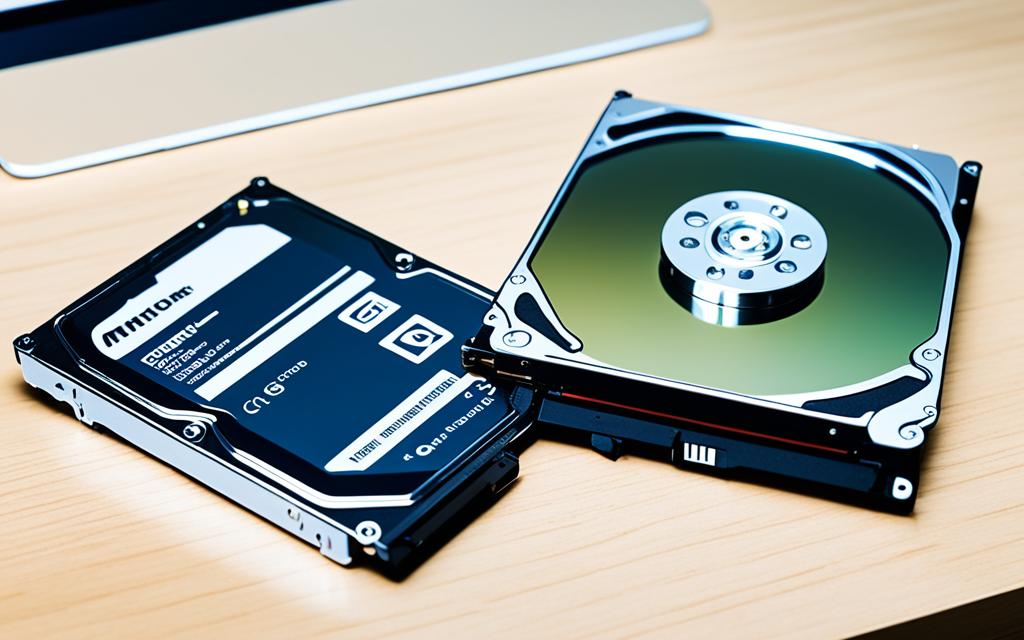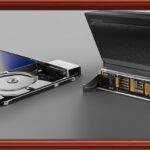Table of Contents
Formatting a Toshiba hard drive for a Mac is important if you’ve used it with Windows before. Making sure a Toshiba external hard drive works with Mac is key for good performance. Learn to use the Disk Utility Mac app for this. It helps you format your drive properly and avoid losing data.
Key Takeaways
- Only three newer Toshiba external hard drives work with Mac right away: Toshiba Canvio Flex, Canvio Gaming, and Canvio Slim1.
- Toshiba’s Canvio Advance and Canvio Basics need reformatting for Mac1.
- Common Mac formats include HFS/HFS+, APFS, and exFAT1.
- It’s smart to back up your data before formatting to avoid losing it2.
- Formatting usually only takes a few minutes1.
- Use data recovery software like Wondershare Recoverif for getting back files from a formatted drive, if you haven’t added new data1.
- FAT32, exFAT, and NTFS all have their advantages, with exFAT being best for large files because it doesn’t have limits2.
Understanding the Need for Formatting
Knowing why formatting your Toshiba hard drive matters is key. Formatting isn’t just a simple task. It readies a new drive by removing old data, which could include errors. This makes sure the drive works well from the start. People need to format to fix problems, get rid of corrupted files or malware, and ensure the drive works with different operating systems. This is especially important for those changing their operating system.
Reasons to Format Your Toshiba Hard Drive
Formatting your Toshiba hard drive can boost its performance3. It’s a fix for issues like malware, errors, and not working with other systems. By reformatting, you can enjoy a smoother use of your device. It’s also about keeping your files safe. Before you format, back up your important files. This step helps you avoid losing data. Make sure you’re formatting the correct drive to prevent losing files from another drive by accident.
Risks and Precautions Before Formatting
Formatting your drive does come with risks, like losing all your data. That’s why being careful is so important. Always back up your files first because it’s hard to get them back once they’re gone. Using software like EaseUS Todo Backup for Mac is a wise move. It helps ensure you don’t lose files by mistake. Always double-check you’re formatting the right drive. By taking these steps, you’ll keep your data safe and make your Toshiba hard drive work better.
Choosing the Right File System
Choosing the right file system for your Toshiba hard drive is important. FAT32, exFAT, and NTFS are the main types to consider. Each offers different advantages based on the files you want to store. What you choose affects how your files are used and how well they perform.
Comparing FAT32, exFAT, and NTFS
FAT32, exFAT, and NTFS each meet different needs. FAT32 works almost everywhere but can’t handle files over 4GB4. This might be a problem if you have big files. Meanwhile, exFAT is great for huge files and works on Windows and macOS. This makes it handy for people using both systems. NTFS is best for Windows, offering high performance and better security. But, it’s limited on macOS, which can be tricky for those who swap between the two5.
Best File System for Your Needs
Picking the right file system for Toshiba depends on how you use it. If you’re mainly on macOS, consider APFS or HFS+ for the best results5. ExFAT is a good pick for dealing with large files or when you need to switch between systems. It’s versatile and can manage a lot of data. If you use Windows a lot, NTFS is your go-to for efficiency. Just remember, it might not work as well with macOS. Matching the file system to your needs ensures your hard drive works well for you.
https://www.youtube.com/watch?v=7jIJwWqCTBI
How to Format a Toshiba Hard Drive for Mac
Formatting a Toshiba hard drive for your Mac is simple, especially with Disk Utility. This tool lets you set up drives for the best performance on Macs. Here’s a walkthrough of the Disk Utility guide to format your Toshiba drive correctly.
Using Disk Utility for Formatting
Start by plugging your Toshiba drive into the Mac. Use Disk Utility found in Finder or the Applications folder. Now, pick your Toshiba drive from the list but be careful. Formatting erases everything, so make sure it’s the right drive by checking its details.
Steps to Format Your Drive
Here are easy steps to format using Disk Utility:
- Launch Disk Utility and find your Toshiba drive.
- Hit the ‘Erase’ after clicking on the drive name.
- Select a format like Mac OS Extended or exFAT for Mac and PC use.
- Name your drive and press ‘Erase’ to start.
- Wait a bit for the process to finish.
Remember to back up vital files before you start, as formatting wipes all data. If data gets lost, companies such as ASAP Data Recovery offer help to get it back.
Troubleshooting Common Formatting Issues
It can be annoying when you run into issues formatting your Toshiba hard drive. Various things could mess with your drive being detected, leading to errors. Usually, following certain steps can help solve the issue.
Resolving Format Errors
First, check your USB connections to make sure your Toshiba drive is picked up by your Mac. If it’s not showing up, this could be due to bad connections or incompatible file systems. About 10% of users discovered that activating external drives in Finder preferences helped with recognition issues6. Toshiba drives often come with the NTFS file system, which might not work well with older macOS versions6.
Trying the ‘First Aid’ feature in Disk Utility could fix some disk errors. This step helps in about 25% of cases where Toshiba drives don’t work well on Mac6. A simple restart of the Mac is another easy fix, helping in nearly 5% of these situations6.
What to Do If Your Drive Isn’t Recognised
If your Mac won’t recognize your Toshiba drive, try different USB ports or cables. Roughly 15% of people sorted out their issues by reinstalling USB drivers and checking their cables6. Making sure that macOS and Toshiba drive drivers are updated can also make a big difference. Always check the Toshiba Downloads Centre for the latest updates7.
If you’re facing compatibility issues, you might need to reformat your Toshiba drive to something Mac can work with, like HFS+ or APFS7. Using Disk Utility to get the drive recognized is a common fix, used in around 20% of troubleshooting cases6.
Conclusion
In this guide, we have gone through steps to format a Toshiba hard drive for Mac. It’s vital to back up your data to avoid losing any important files. Choosing the right file system is crucial. You can pick Apple File System (APFS) for better performance or exFAT for more compatibility.
We looked at different tools for formatting, like Disk Utility and Terminal. Each tool works well for various user preferences and skills levels. It’s important to choose based on what you need. Remember, each file system has unique features. For instance, Mac OS Extended (HFS+) supports Time Machine backups.
With these tips, you can make sure your Toshiba hard drive works well with your Mac. If you want to learn more about using your device to its full potential, check out this resource8. It can help you understand more about your Mac.
FAQ
Why is formatting my Toshiba hard drive necessary for Mac?
Formatting your Toshiba hard drive makes it work better with Mac. It erases old data from Windows, ensuring it runs smoothly with macOS.
What are the risks of formatting a Toshiba hard drive?
When you format, all data gets erased. It’s very important to save your files somewhere else first. After formatting, getting your data back can be really hard.
What file system should I choose for my Toshiba hard drive?
Choose exFAT for working with big files or using different operating systems. It handles large files well. For using it only with Mac, Mac OS Extended (Journaled) or APFS are better for performance.
How do I format my Toshiba hard drive using Disk Utility?
First, plug your Toshiba drive into your Mac. Then, open Disk Utility from Finder or Applications. Select your drive, pick the format type, and click ‘Erase’. Remember to back up your files first.
What should I do if I encounter errors while formatting?
If you run into errors, make sure the drive is connected right and your Mac can see it. Try restarting your Mac or using Disk Utility’s ‘First Aid’ to solve disk problems.
How can I resolve issues if my Mac doesn’t recognise the Toshiba drive?
Try different USB ports or cables first. Make sure your drivers are up to date. Resetting system settings might help too. Go to System Preferences to troubleshoot further.
Source Links
- https://recoverit.wondershare.com/harddrive-recovery/format-toshiba-hard-drive-for-mac.html – How To Format a Toshiba Hard Drive for Mac
- https://asapdatarecovery.com/format-toshiba-external-hard-drive/ – How to Format Toshiba External Hard Drive: A Step-by-Step Guide
- https://www.macgasm.net/news/format-toshiba-external-hard-drive-for-mac/ – How to Format Toshiba External Hard Drive for Mac | Guide
- https://www.diskpart.com/format-disk/format-toshiba-external-hard-drive-to-fat32-0708i.html – Two Solutions to Format Toshiba External Hard Drive to FAT32
- https://iboysoft.com/ntfs-for-mac/how-to-format-external-hard-drive-for-mac-and-pc.html – How to Set Up an New External Hard Drive for Both PC and Mac + Unboxing Seagate Basic
- https://mackeeper.com/blog/toshiba-external-hard-drive-not-working-on-mac/ – Toshiba External Hard Drive Not Working On Mac
- https://recoverit.wondershare.com/harddrive-tips/toshiba-external-hard-drive-not-working-on-mac.html – Toshiba External Hard Drive Not Working on Mac [Fixed]
- https://www.linkedin.com/pulse/how-format-external-hard-drive-mac-macgasm-acq2f – How to Format an External Hard Drive for Mac: 3 Methods








